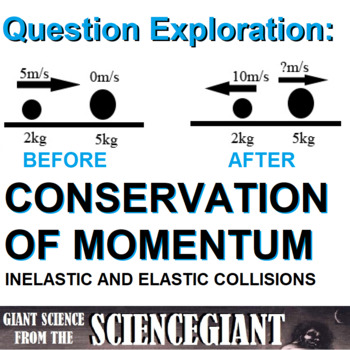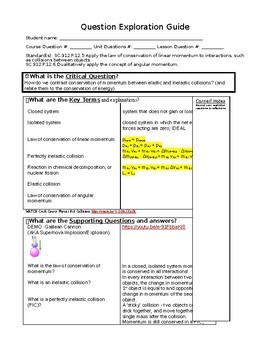Question Exploration: Conservation of Momentum in Collisions
- Word Document File
Also included in
- Teachers use the Strategic Instruction Model (SIM) Framing Routine to transform abstract main ideas and key topics into a concrete representation that helps students think about and talk about the key topic and essential related information. SIM is about promoting effective teaching and learning ofPrice $2.62Original Price $3.88Save $1.26
Description
Momentum is building? Is it conserved in a collision or explosion?This Question Exploration explains How do we contrast conservation of momentum between elastic and inelastic collisions? This is an AP Physics 1 topic.
Question Exploration Routines are instructional methods that teachers can use to help a diverse student population understand a body of content information by carefully answering a critical question to arrive at a main idea answer. Students taught using the content enhancement routines earned higher total test scores than did students taught using the lecture-discussion method.
Personally, I use the Content Enhancement Routines to figure out what I want to say and how I want to say it. It keeps my "Sage on the Stage" time limited to what fits onto 2-3 pages (about 45 minutes of directed class discussion).
This product includes both the completed concept comparison, and the student guide blanked except for vocabulary, scaffolding questions, and graphics already filled in. It includes warm ups, worksheets, and recommended videos for review, and it's is in Microsoft Word .doc form so that Ts can customize the discussion to fit the needs of their Ss.
This Content Enhancement Routine is classroom tested to help students with the following Florida Next Generation Sunshine State Standards in Science.
- SC.912.P.12.5 Apply the law of conservation of linear momentum to interactions, such as collisions between objects.
- SC.912.P.12.6 Qualitatively apply the concept of angular momentum.
Students Will Be Able To (SWBAT):
- Use (and recall) the definition of linear momentum, and show an understanding of its vector nature in 1 dimension.
- Understand and use conservation of linear momentum, in 1 dimension, and solve simple problems involving direct collision of two bodies before and after impact.
#StayGiant and stay up on my new resources and STEM news. Look for the green ★ star near the top of any page within my store and click "FOLLOW". Or follow @TheScienceGiant Twitter. Stand on The Shoulders of Giants, and together we'll see further, inspire students, and enlighten inquisitive minds!






